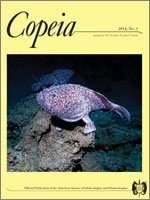Non-modal scute patterns are observed more frequently in hatchlings than in adult sea turtles, which suggests greater survival of hatchlings with the modal scute pattern. Here we compare morphological parameters and fitness correlates of hatchlings of Caretta caretta and Natator depressus with the modal scute pattern against those with non-modal scute patterns. We found hatchlings with the modal scute pattern were larger and heavier than those with non-modal scute patterns; however, this size difference did not translate into a difference in crawling speed or self-righting ability for either species. There was also no difference in swim thrust produced by hatchlings of C. caretta over the first four hours of swimming; however, hatchlings of N. depressus with the modal pattern produced greater swim thrust during the first 40 minutes of swimming than those with non-modal scute patterns. This difference may affect the risk of predation and mortality at this early life stage.
How to translate text using browser tools
1 March 2014
Non-modal Scute Patterns, Morphology, and Locomotor Performance of Loggerhead (Caretta caretta) and Flatback (Natator depressus) Turtle Hatchlings
Elizabeth L. Sim,
David T. Booth,
Colin J. Limpus
ACCESS THE FULL ARTICLE





